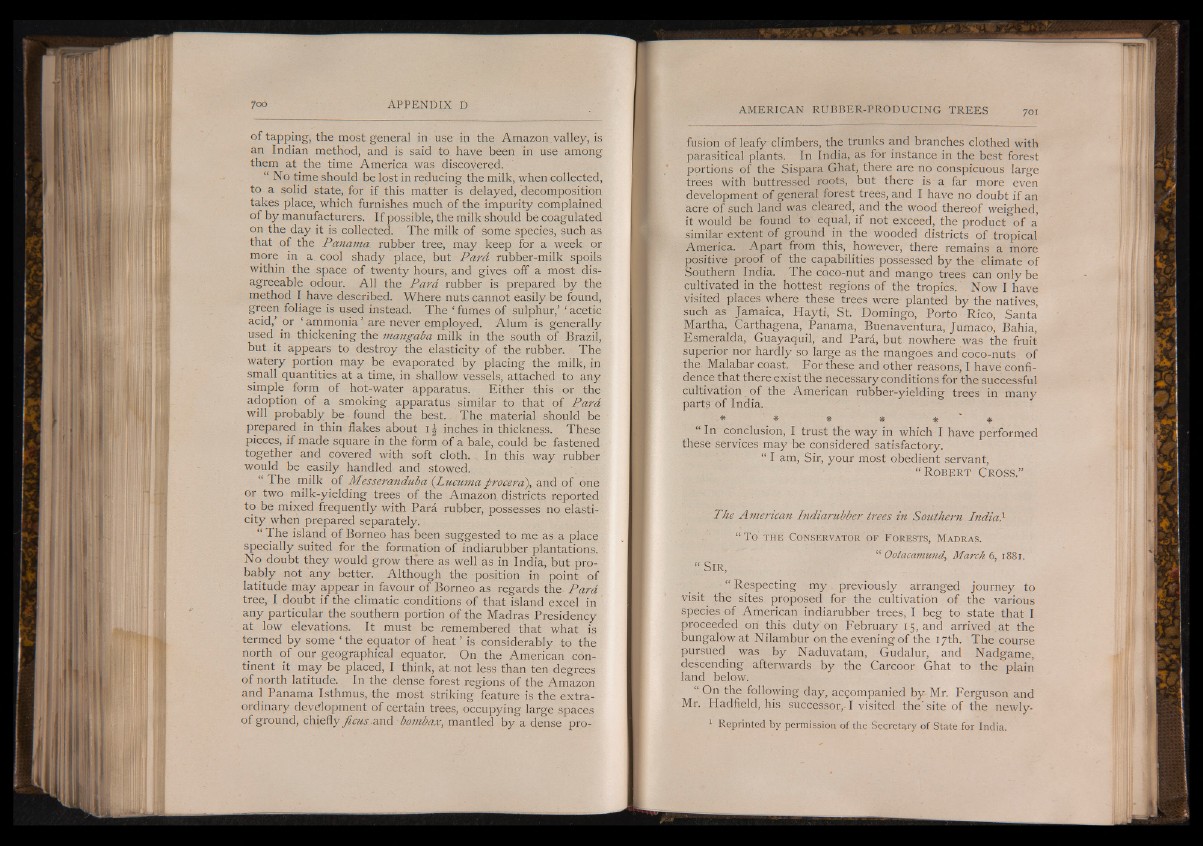
A p p e n d i x d
of tapping, the most general in use in the Amazon valley, is
an Indian method, and is said to have been in use among
them at the time America was discovered.
“ No time should be lost in reducing the milk, when collected,
to a solid state, for if this matter is delayed, decomposition
takes place, which furnishes much of the impurity complained
of by manufacturers. I f possible, the milk should be coagulated
on the day it is collected. The milk of some species, such as
that of the Panama rubber tree, may keep for a week or
more in a cool shady place, but Para rubber-milk spoils
within the space of twenty hours, and gives off a most disagreeable
odour. All the Para rubber is prepared by the
method I have described. Where nuts cannot easily be found,
green foliage is used instead. The ‘ fumes of sulphur,’ ‘ acetic
acid,’ or ‘ ammonia ’ are never employed. Alum is generally
used in thickening the mangaba milk in the south of Brazil,
but it appears to destroy the elasticity of the rubber. The
watery portion may be evaporated by placing the milk, in
small quantities at a time, in shallow vessels, attached to any
simple form of hot-water apparatus. Either this or the
adoption of a smoking apparatus similar to that of Para
will probably be found the best. The material should be
prepared in thin flakes about I in c h e s in thickness. These
pieces, if made square in the form of a bale, could be fastened
together and covered with soft cloth. In this way rubber
would be easily handled and stowed.
“ The milk of Messeranduba (Lucuma procerd), and of one
or two milk-yielding trees of the Amazon districts reported
to be mixed frequently with Para rubber, possesses no elasticity
when prepared separately.
“ The island of Borneo has been suggested to me as a place
specially suited for the formation of indiarubber plantations.
No doubt they would grow there as well as in India, but probably
not any better. Although the position in point of
latitude may appear in favour of Borneo as regards the Para
tree, I doubt if the climatic conditions of that island excel in
any particular the southern portion of the Madras Presidency
at low elevations. It must be remembered that what is
termed by some ‘ the equator of heat ’ is considerably to the
north of our geographical equator. On the American continent
it may be placed, I think, at not less than ten degrees
of north latitude. In the dense forest regions of the Amazon
and Panama Isthmus, the most striking feature is the extraordinary
development of certain trees, occupying large spaces
of ground, chiefly ficus.and bombax, mantled by a dense profusion
of leafy climbers, the trunks and branches clothed with
parasitical plants. In India, as for instance in the best forest
portions of the Sispara Ghat; there are no conspicuous large
trees with buttressed roots, but there is a far more even
development of general forest trees, and I have no doubt if an
acre of such land was cleared, and the wood thereof weighed,
it would be found to equal, if not exceed, the product of a
similar extent of ground in the wooded districts of tropical
America. Apart from this, however, there remains a more
positive proof of the capabilities'possessed by the climate of
Southern India. The coco-nut and mango trees can only be
cultivated in the hottest regions of the tropics.' Now I have
visited places where these trees were planted by the natives,
such as Jamaica, Hayti, St. Domingo, Porto Rico, Santa
Martha, Carthagena, Panama, Buenaventura, Jumaco, Bahia,
Esmeralda, Guayaquil, and Para, but nowhere was the fruit
superior nor hardly so large as the mangoes and coco-nuts of
the Malabar coast. For these and other reasons, I have confidence
that there exist the necessary conditions for the successful
cultivation of the American rubber-yielding trees in many
parts of India.
■* * * * * %
“ In conclusion, I trust the way in which I have performed
these services may be considered satisfactory.
“ I am, Sir, your most obedient servant,
1 R o b e r t C r o s s . ”
The American Indiarubber trees in Southern India}
“ T o’ t h e C o n s e r v a t o r o f F o r e s t s , M a d r a s .
Ootacamund.> March 6, 1881.
“ S ir ,
“ Respecting m y . previously arranged journey to
visit the sites proposed for the cultivation of the various
species of American indiarubber trees, I beg to state that I
proceeded on this duty"on February 15, and arrived at the
bungalow at Nilambur on the evening of the 17th. The course
pursued was by Naduvatam, Gudalur, and Nadgame,
descending afterwards by the Carcoor Ghat to the plain
land below.
“ On the following day, accompanied by Mr. Ferguson and
Mr. Hadfield, his successor,-! visited the'site of the newly-
1 Reprinted by permission of the Secretary of State for India.